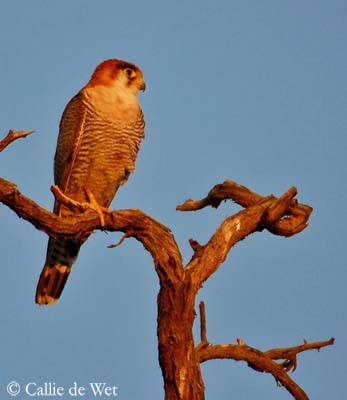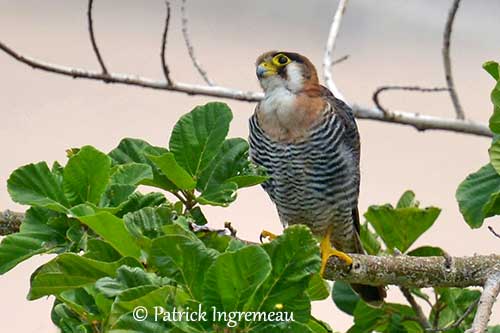
Fr: Faucon chicquera
All : Rothalsfalke
Esp : Alcotán Turumti
Ital : Falco testarossa
Nd : Roodkopsmelleken
Russe : Красношейный сокол
Sd : Rödhuvad falk
Photographers:
Steve Garvie
RAINBIRDER Photo galleries
Patrick Ingremeau
TAMANDUA
Jean Marc Rabby
Des Ailes et des Plumes
Callie de Wet
GALLERY
Text by Nicole Bouglouan
Sources:
HANDBOOK OF THE BIRDS OF THE WORLD Vol 2 by Josep del Hoyo-Andrew Elliot-Jordi Sargatal - Lynx Edicions - ISBN: 8487334156
BIRDS OF PREY OF AFRICA AND ITS ISLANDS by Alan and Meg Kemp - Struik Publishers - ISBN: 1770073698
Global Raptor Information Network - Working to Conserve Birds of Prey in nature
Pakistan’s First Birding Guide
Red-necked Falcon Falco chicquera nesting on an electricity pylon
Wikipedia, the free encyclopaedia
Red-necked Falcon
Falco chicquera
Falconiforme Order – Falconidae Family
INTRODUCTION:
The Red-necked Falcon has two disjunct populations, one in India and the other in Africa where two races are recognized depending on the authors.
They frequent open areas with sparse vegetation and scattered large trees, or palm trees in Africa, and can be seen sometimes nesting in large cities in India. Both are visible from sea-level to 1,000 and 1,300 metres of elevation.
They typically feed on birds and bats, and also take large insects. They hunt with an agile flight after pursuing their prey.
They nest in stick nests abandoned by other species. Both adults rear the chicks.
The Red-necked Falcon is affected by habitat degradation and destruction in Asia where it is Near Threatened, whereas the African races are described as “uncommon” and currently, they are not globally threatened.

DESCRIPTION OF THE BIRD:
Biometrics:
Length: 28-36 cm
Wingspan: 55-69 cm
Weight: M: 139-178 g - F: 190-305 g
The Red-necked Falcon is a small, short-winged falcon with long tail rounded at tip.
In the nominate race, the upperparts are blue-grey, finely barred with dark grey to black. The flight feathers are black. The fairly long tail is grey with narrow black bars, then a broad, black subterminal black band and a white tip.
On the underparts, chin, throat and breast are pinkish-rufous or white. Rest of underparts, including wing coverts, belly, vent and thighs are white or pale grey, finely barred with black. The tail is whitish, finely barred with black, and with subterminal black band and white tip.
Crown, nape and hindneck are rich chestnut. The cheeks are pinkish-rufous to white. Eyebrow and malar stripe are black.
The bill is black, with yellow base and cere. The eyes are dark brown with yellow, bare eyering. The long, slender bare legs and the feet are bright yellow. The claws are black.
Both sexes are similar in plumage, but the female is about 10% larger than male.
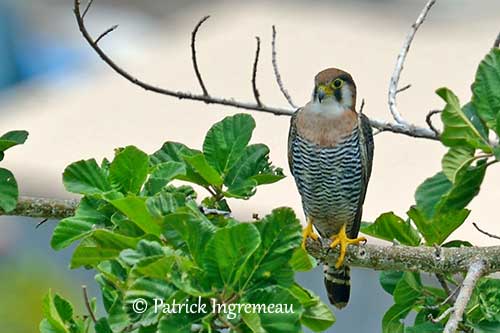
The juvenile resembles adult but the upperparts has washed brown, especially on mantle and upper back. Crown, hindneck and forehead are dull red-brown, instead of chestnut. The underparts are pale rufous with indistinct barring, almost unmarked, except on the barred flanks.
SUBSPECIES AND RANGE:
The Red-necked Falcon is an uncommon resident in sub-Saharan Africa, and in India and Nepal.
Three subspecies share the large range.
The Asian race F. chicquera chicquera (described above) is found is SE Iran, E through Pakistan and India to Nepal and Bangladesh.
The Indian form has rufous crown, nape and moustachial stripe, and it is less heavily barred than African species.
There are two African races:
F. chicquera ruficollis is found in S Mauritania, Senegambia, Guinea to Nigeria, and E to Ethiopia, then to Zambia, Malawi and N Mozambique.
This race has white face with black malar stripe. On the pale grey upperparts, the primary flight-feathers are black and the tail shows a broad, dark band. The white underparts are barred blackish on underwing, lower breast, belly and undertail.
We can see a rufous band on the foreneck (absent in the Indian race).
F. chicquera horsbrughi occurs S of R Zambezi, from Zimbabwe and S Mozambique W to Botswana, Namibia and S Angola, and S to N South Africa.
This race was described by J.W.B. Gunning (a Dutch physician) and Austin Roberts (a South African zoologist) in 1911, based on a single specimen. This subspecies may be not valid and may be not recognized.
A rare observation of the Red-necked Falcon was recently done in Mayotte, in the Indian Ocean, in October 2020.
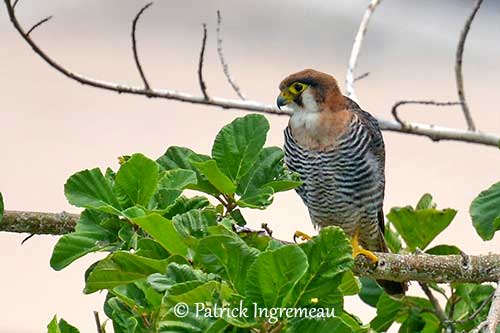
HABITAT:
The Red-necked Falcon lives in semi-desert, palm savannahs, open areas with sparse vegetation and scattered large trees, watercourses in desert, flood and coastal plains, and forest edges.
The Asian race nests frequently around villages, and even in large cities in India. It is visible from sea-level up to 1,000 metres of elevation.
The African races are common in habitats with palm tree species, in grassy savannas near rivers, arid country with acacias, often near water. They are visible from sea-level up to 1,000 metres, and 1,300 metres of elevation in Malawi.
CALLS AND SONGS: SOUNDS BY XENO- CANTO
The Red-necked Falcon of the Asian race is usually silent outside of breeding season. The calls include shrill, querulous screams “ki-ki-ki-ki-ki” and we can also hear a rasping “yak,yak,yak”.
The Red-necked Falcon of African races calls infrequently. But it may utter high, repeated, sharp notes, and shrill, screaming “kek-kek-kek-kek-kek”.
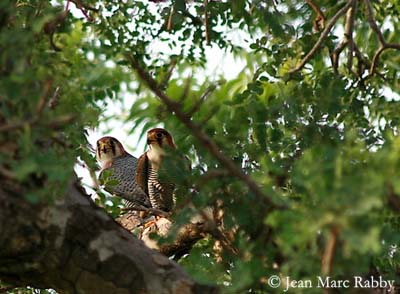
BEHAVIOUR IN THE WILD:
The Red-necked Falcon feeds on birds and bats caught on the wing. It also consumes large insects taken on the ground.
They often hunt in pairs. One of the birds flies low above the ground and flushes up small birds. The other follows the prey higher and catches it at the edge of the cover. They are more active at dawn and dusk.
It also dashes after prey from an exposed perch below the canopy of a tree. It soars and dives down on prey less often than other birds of prey, but it may catch birds in flight, after a long, fast pursuit.
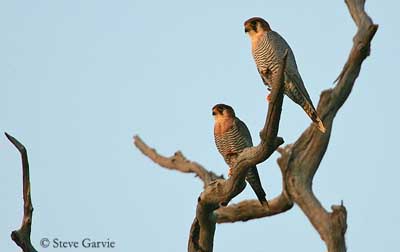
The Red-necked Falcon is known to use abandoned stick nests of other Raptors or Corvidae, placed in trees or sometimes in man-made structure. The female incubates and feeds the young with the prey brought by the male during this period. But she also hunts for short periods around the nest.
The Red-necked Falcon is resident and nomadic, performing some dispersion, according to food resources.
The African races are mostly sedentary, but they may move depending on prey abundance and droughts.
This species performs a dashing flight, with rapid beats of its pointed wings. Flapping is interspersed with glides. It flies very fast with rapid, powerful wingbeats.
REPRODUCTION OF THIS SPECIES:
The breeding period occurs mainly in dry season, in December/May in India and February/April in Pakistan. The African races nest from February to November, depending on the range.
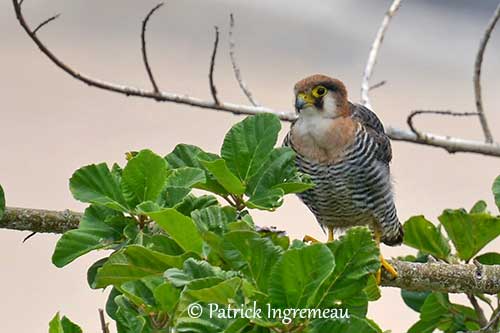
The Red-necked Falcon nests in old stick nests, abandoned by other birds. The nest is generally at top of an isolated tree, or in palm tree, at 3-15 metres in Asian race, to 2-9 metres in African races. The same nest-site is often reused. They do not add material.
The female lays 3 to 4 eggs on debris accumulated in the base of palm frondescence or in the nest. The incubation lasts about 32 to 35 days. At hatching, the chicks have white down. They fledge 34-40 days after hatching.
In India, this period may last up to 48 days, and the young are independent 69-72 days after hatching.
In Africa, the post-fledging dependency period usually lasts 3 weeks.
PROTECTION / THREATS / STATUS:
The Red-necked Falcon is threatened by rapid urbanisation and development, involving declines in some parts of the range. Intensive use of pesticides in Nepal caused important decline of the population, and the species is now absent from this country since at least the last 25 years.
The global population is roughly estimated to number in the tens of thousands, and is suspected to be affected by a moderately rapid decline, mainly due to habitat destruction.
The Asian species is currently considered Near Threatened.
In Africa, it is described as “uncommon” in most part of the range. The African species are evaluated as Least Concern.
